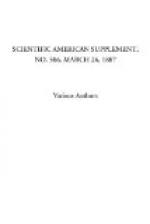Now let us look at some smoke consumers. The diagrams show those of Chubb, Growthorpe, Ireland and Lowndes, and of Gregory. You see that they all admit air at the “bridge” or back of the fire, and that this air is warmed either by passing under or round the furnace, or in one case through hollow fire bars. The regulation of the air supply is effected by hand, and it is clear that some of these arrangements are liable to admit an unnecessary supply of air, while others scarcely admit enough, especially when fresh coal is put on. This is the difficulty with all these arrangements when used with ordinary hand—i.e., intermittent—stoking. Two plans are open to us to overcome the difficulty. Either the stoking and the air supply must both be regular and continuous, or the air supply be made intermittent to suit the stoking. The first method is carried out in any of the many forms of mechanical stoker, of which this of Sinclair’s is an admirable specimen. Fresh fuel is perpetually being pushed on in front, and by alternate movement of the fire bars the fire is kept in perpetual motion till the ashes drop out at the back. To such an arrangement as this a steady air supply can be adjusted, and if the boiler demand is constant there is no need for smoke, and an inferior fuel may be used. The other plan is to vary the air supply to suit the stoking. This is effected by Prideaux automatic furnace doors, which have louvers to remain open for a certain time after the doors are shut, and so to admit extra air immediately after coal has been put on, the supply gradually decreasing as distillation ceases. The worst of air admitted through chinks in the doors, or through partly open doors, is that it is admitted cold, and scarcely gets thoroughly warm before it is among the stuff it has to burn. Still this is not a fatal objection, though a hot blast would be better. Nothing can be worse than shoveling on a quantity of coal and shutting it up completely. Every condition of combustion is thus violated, and the intended furnace is a mere gas retort.
Gas Producers.—Suppose the conditions of combustion are purposely violated; we at once have a gas producer. That is all gas producers are, extra bad stoves or furnaces, not always much worse than things which pretend to serve for combustion. Consider how ordinary gas is made. There is a red-hot retort or cylinder plunged in a furnace. Into this tube you shovel a quantity of coal, which flames vigorously as long as the door is open, but when it is full you shut the door, thus cutting off the supply of air and extinguishing the flame. Gas is now simply distilled, and passes along pipes to be purified and stored. You perceive at once that the difference between a gas retort and an ordinary furnace with closed doors and half choked fire bars is not very great. Consumption of smoke! It is not smoke consumers you really want, it is fuel consumers. You distill your fuel instead of burning




